« Physics - 10th grade"
Electricity- directed movement of charged particles. Thanks to electric current, apartments are illuminated, machine tools are set in motion, burners on electric stoves are heated, the radio operates, etc.
Let's consider the simplest case of directed motion of charged particles - direct current.
What electric charge is called elementary?
What is the elementary electric charge?
What is the difference between charges in a conductor and a dielectric?
When charged particles move in a conductor, transfer occurs electric charge from one point to another. However, if charged particles undergo random thermal motion, such as free electrons in a metal, then charge transfer does not occur (Fig. 15.1, a). The cross-section of a conductor, on average, crosses the same number of electrons in two opposite directions. Electric charge is transferred through the cross section of a conductor only if, along with random movement, electrons participate in directed movement (Fig. 15.1, b). In this case, they say that the conductor goes electricity .
Electric current is the ordered (directed) movement of charged particles.
Electric current has a certain direction.
The direction of current is taken to be the direction of movement of positively charged particles.
If you move an overall neutral body, then, despite the ordered movement of a huge number of electrons and atomic nuclei, no electric current will occur. The total charge transferred through any cross section will be equal to zero, since charges of different signs move with the same average speed.
The direction of the current coincides with the direction of the voltage vector electric field. If the current is formed by the movement of negatively charged particles, then the direction of the current is considered opposite to the direction of movement of the particles.
The choice of current direction is not very successful, since in most cases the current represents the ordered movement of electrons - negatively charged particles. The choice of current direction was made at a time when nothing was known about free electrons in metals.
Action of current.
We do not directly see the movement of particles in a conductor. The presence of electric current must be judged by the actions or phenomena that accompany it.
Firstly, the conductor through which the current flows heats up.
Secondly, electric current can change chemical composition conductor: for example, isolating its chemical components (copper from a solution copper sulfate etc.).
Thirdly, the current exerts a force on neighboring currents and magnetized bodies. This action of current is called magnetic.
Thus, a magnetic needle near a current-carrying conductor rotates. The magnetic effect of current, in contrast to chemical and thermal, is the main one, since it manifests itself in all conductors without exception. Chemical action current is observed only in solutions and melts of electrolytes, and heating is absent in superconductors.
In an incandescent light bulb, due to the passage of electric current, visible light is emitted, and the electric motor performs mechanical work.
Current strength.
If an electric current flows in a circuit, this means that an electric charge is constantly being transferred through the cross-section of the conductor.
The charge transferred per unit time serves as the main quantitative characteristic of the current, called current strength.
If a charge Δq is transferred through the cross section of a conductor during a time Δt, then the average value of the current is equal to
The average current strength is equal to the ratio of the charge Δq passing through the cross section of the conductor during the time interval Δt to this period of time.
If the current strength does not change over time, then the current is called permanent.
Force alternating current V this moment time is also determined by formula (15.1), but the time interval Δt in this case should be very small.
Current strength, like charge, is a scalar quantity. She might be like positive, so negative. The sign of the current depends on which of the directions around the circuit is taken as positive. Current strength I > 0 if the direction of the current coincides with the conditionally chosen positive direction along the conductor. Otherwise I< 0.
Relationship between current strength and the speed of directional movement of particles.
Let a cylindrical conductor (Fig. 15.2) have a cross section with area S.
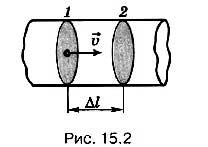
For the positive direction of current in a conductor we take the direction from left to right. The charge of each particle will be considered equal to q 0. The volume of the conductor, limited by cross sections 1 and 2 with a distance Δl between them, contains nSΔl particles, where n is the concentration of particles (current carriers). Their total charge in the selected volume is q = q 0 nSΔl. If particles move from left to right with an average speed υ, then during the time all particles contained in the volume under consideration will pass through cross section 2. Therefore, the current strength is equal to:
The SI unit of current is ampere (A).
This unit is established on the basis of the magnetic interaction of currents.
Measure current strength ammeters. The design principle of these devices is based on magnetic action current
The speed of ordered movement of electrons in a conductor.
Let's find the speed of ordered movement of electrons in a metal conductor. According to formula (15.2) where e is the modulus of the electron charge.
Let, for example, the current strength I = 1 A, and the cross-sectional area of the conductor S = 10 -6 m 2. Electron charge modulus e = 1.6 10 -19 C. The number of electrons in 1 m 3 of copper is equal to the number of atoms in this volume, since one of the valence electrons of each copper atom is free. This number is n ≈ 8.5 10 28 m -3 (this number can be determined by solving problem 6 from § 54). Hence,
As you can see, the speed of ordered movement of electrons is very low. It is many times less than the speed of thermal motion of electrons in the metal.
Conditions necessary for the existence of electric current.
For the emergence and existence of a constant electric current in a substance, it is necessary to have free charged particles.
However, this is still not enough for a current to occur.
To create and maintain the ordered movement of charged particles, a force is required that acts on them in a certain direction.
If this force ceases to act, then the ordered movement of charged particles will cease due to collisions with ions crystal lattice metals or neutral electrolyte molecules and the electrons will move randomly.
As we know, charged particles are affected by electric field with force:
Typically, it is the electric field inside the conductor that causes and maintains the ordered movement of charged particles.
Only in the static case, when the charges are at rest, the electric field inside the conductor is zero.
If there is an electric field inside the conductor, then there is a potential difference between the ends of the conductor in accordance with formula (14.21). As the experiment showed, when the potential difference does not change over time, a direct electric current. Along the conductor, the potential decreases from the maximum value at one end of the conductor to the minimum at the other, since the positive charge, under the influence of field forces, moves in the direction of decreasing potential.
These charged particles are often called current carriers in theory. In conductors and semiconductors, current carriers are electrons; in electrolytes, charged ions. In gases, charge carriers can be both electrons and ions. In metals, for example, only electrons can move. Consequently, the electric current in them is the movement of conduction electrons. It should be noted that the result of the passage of electric current in metals and electrically conducting solutions is significantly different. No chemical processes occur in metals when current passes. Whereas in electrolytes, under the influence of current, substance ions are released on the electrodes (the phenomenon of electrolysis). The difference in the results of the action of current is explained by the fact that the charge carriers in the metal and electrolyte are fundamentally different. In metals these are free electrons that have separated from atoms; in solutions these are ions, that is, atoms or their groups that have a charge.
Yes, first a necessary condition The existence of electric current in any substance is the presence of current carriers.
In order for the charges to be in equilibrium, it is necessary that the potential difference between any points of the conductor be equal to zero. If this condition is violated, then there is no equilibrium, then the charge moves. Therefore, the second necessary condition for the existence of electric current in a conductor is the creation of voltage between certain points.
The ordered movement of free charges that occurs in a conductor as a result of the action of an electric field is called conduction current.
However, we note that the ordered movement of charged particles is possible if a charged conductor or dielectric is moved in space. Such an electric current is called convection current.
Direct current implementation mechanism
In order for the current to flow constantly in a conductor, it is necessary that some device be connected to the conductor (or a set of conductors - a chain of conductors), in which the process of separation of electrical charges constantly occurs and thereby maintains the voltage in the circuit. This device is called a current source (generator). The forces that separate charges are called extraneous forces. They are non-electrical in origin and act only inside the source. When charges separate, external forces create a potential difference between the ends of the circuit.
If an electric charge moves along a closed circuit, then the work done by electrostatic forces is zero. This means that the total work of forces ($A$) that act on the charge is equal to the work of external forces ($A_(st)$). Physical quantity, which characterizes the current source - this is EMF source($(\mathcal E)$), it is defined as:
\[(\mathcal E)=\frac(A)(q)\left(1\right),\]
where $q$ is a positive charge. The charge moves along closed loop. EMF is not a force in the literal sense. Unit of measurement $\left[(\mathcal E)\right]=В$.
The nature of external forces can be different, for example, in a galvanic cell, external forces are the result of electrochemical processes. In car direct current such a force is the Lorentz force.
Main characteristics of current
The direction of the current is conventionally considered to be the direction of movement of positive particles. This means that the direction of current in metals is opposite to the direction of particle movement.
Electric current is characterized by current strength. Current ($I$) -- scalar quantity, which is equal to the derivative of the charge ($q$) with respect to time for the current that flows through the surface S:
The current can be constant or alternating. If the current strength and its direction do not change over time, then such a current is called constant and for it the expression for the current strength can be written as:
where the current is defined as the charge that passes through the surface S per unit time.
In the SI system, the basic unit of current is the Ampere (A).
The local vector characteristic of the current is its density. The current density vector ($\overrightarrow(j)$) characterizes how the current is distributed over the cross section S. This vector is directed in the direction in which the positive charges are moving. The modulus of the current density vector is equal to:
where $dS"$ is the projection of the elementary surface $dS$ onto a plane that is perpendicular to the current density vector, $dI$ is the element of current that flows through the surfaces $dS\ and\ dS"$.
The current density in a metal can be represented as:
\[\overrightarrow(j)=-n_0q_e\left\langle \overrightarrow(v)\right\rangle \ \left(5\right),\]
where $n_0$ is the concentration of conduction electrons, $q_e=1.6(\cdot 10)^(-19)C$ is the electron charge, $\left\langle \overrightarrow(v)\right\rangle $ -- average speed ordered movement of electrons. At maximum current densities $\left\langle \overrightarrow(v)\right\rangle =(10)^(-4)\frac(m)(s)$.
The fundamental physical law is the law of conservation of electric charge. If we choose an arbitrary closed stationary surface S (Fig. 1), which limits the volume V, then the amount of electricity that flows per second from the volume V is defined as $\oint\limits_S(j_ndS.)$ The same amount of electricity can be expressed in terms of charge : $-\frac(\partial q)(\partial t)$, that is, we have:
\[\frac(\partial q)(\partial t)=-\oint\limits_S(j_ndS\left(6\right),)\]
where $j_n$ is the projection of the current density vector onto the direction of the normal to the surface element $dS$, in this case:
where $\alpha $ is the angle between the direction of the normal to dS and the current density vector. Equation (6) uses a partial derivative to emphasize that the surface S is stationary.
Equation (6) is the law of conservation of charge in macroscopic electrodynamics. If the current is constant over time, then we write the law of conservation of charge in the form:
\[\oint\limits_S(j_ndS=0\left(8\right).)\]
Full text search:
Home > Abstract >Physics
Lecture No. 12
Subject: "Electricity".
Purpose of the lecture:
Lecture plan.
1. The concept of conduction current. Current vector and current strength.
2. Differential form of Ohm's law.
3. Consistent and parallel connection conductors.
4. The reason for the appearance of an electric field in a conductor, physical
the meaning of the concept of external forces.
5. Derivation of Ohm's law for the entire circuit.
6. Kirchhoff's first and second rules.
7. Contact potential difference. Thermoelectric phenomena.
8. Electric current in various environments.
9. Current in liquids. Electrolysis. Faraday's laws.
1. The concept of conduction current. Current vector and current strength.
Electric shock called the ordered movement of electric charges. Current carriers can be electrons, ions, and charged particles.
If an electric field is created in a conductor, then free electric charges in it will begin to move - a current appears, called conduction current. If a charged body moves in space, then current called convection.
Current can flow into solids(metals), liquids (electrolytes) and gases (gas discharge is caused by the movement of both positive and negative charges).
Current carriers are:
In metals - directed movement of electrons;
In liquids - ions;
In gases - electrons and ions.
For the direction of the current It is customary to accept the direction of movement of positive charges.
For the occurrence and existence of current it is necessary:
the presence of free charged particles;
the presence of an electric field in a conductor.
The main characteristic of current is current strength , which is equal to the amount of charge passing through the cross section of the conductor in 1 second.

where q is the amount of charge;
t – charge transit time.
Current strength is a scalar quantity.
A current whose strength and direction do not change over time is called permanent , otherwise - variables .
The electric current over the surface of the conductor may be distributed unevenly, so in some cases they use concept of current density i .
The average current density is equal to the ratio of the current strength to the cross-sectional area of the conductor.
 ,
, 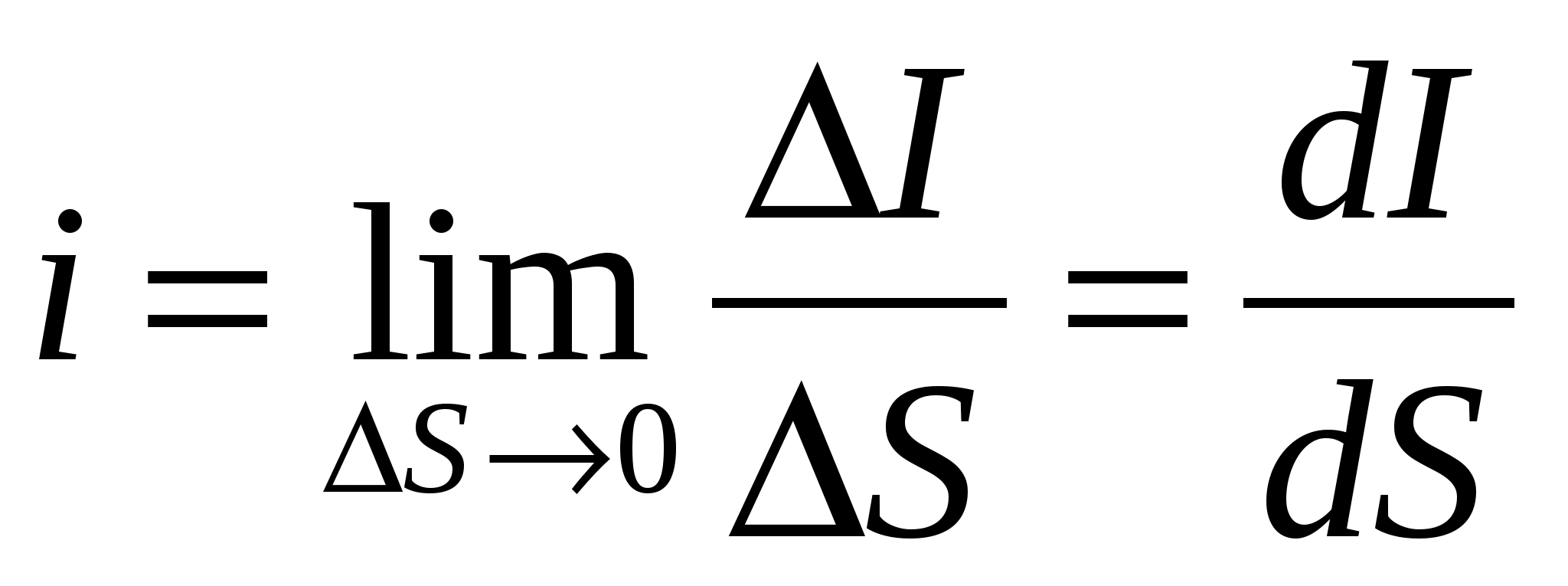
 , (2)
, (2)
where J is the change in current;
S – change in area.
2. Differential form of Ohm's law.
In 1826, the German physicist Ohm experimentally established that the current strength J in a conductor is directly proportional to the voltage U between its ends
 , (3)
, (3)
where k is the proportionality coefficient, called
electrical conductivity or conductivity; [k] = [Sm] (Siemens).
Magnitude ![]() (4)
(4)
called electrical resistance of the conductor .
We get the expression
 . (5)
. (5)
Ohm's law for a site electrical circuit, not containing a current source
We express from this formula R
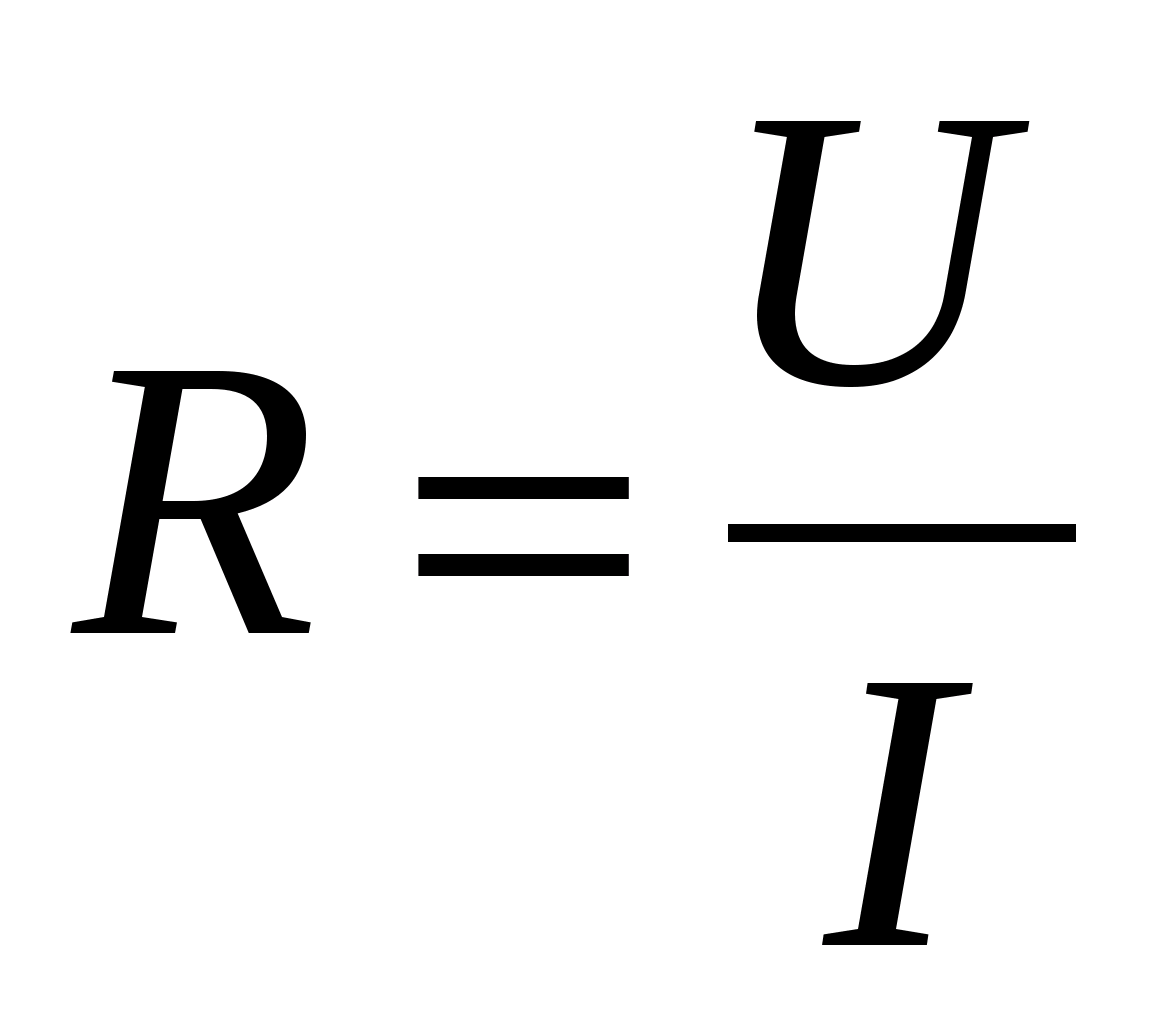 .
.  (6)
(6)
Electrical resistance depends on the shape, size and substance of the conductor.
Conductor resistance directly proportional to its length l and inversely proportional to the cross-sectional area S.
 , (7)
, (7)
where – characterizes the material from which the conductor is made and
called conductor resistivity
.
Let us express :

 . (8)
. (8)
Conductor resistance depends on temperature. As temperature increases, resistance increases
where R 0 – conductor resistance at 0С;
t – temperature;
– temperature coefficient of resistance
(for metal 0.04 deg -1).
The formula is also valid for resistivity
 , (10)
, (10)
where 0 – resistivity conductor at 0С.
At low temperatures (<8К) сопротивление некоторых металлов (алюминий, свинец, цинк и др.) скачкообразно уменьшается до нуля: металл становится absolute guide.
This phenomenon is called superconductivity .
Let's substitute expression (7) into (5)
 . (11)
. (11)
Let's rearrange the expression terms
 , (12)
, (12)
where J/S=i – current density;
1/= – specific conductivity of the conductor substance;
u/е=E – electric field strength in the conductor.
 (13)
(13)
Ohm's law in differential form.
3. The reason for the appearance of electric current in the conductor.
Physical meaning of the concept of external forces. The work of outside forces.
Ohm's law shows that current density is directly proportional to voltage E electric field acting on free charges and causing their ordered movement.
What is the electric field in a conductor? This is an electrostatic field created by electrons and positive ions (Coulomb force field).
Coulomb forces lead to a redistribution of free charges in which the electric field in the conductor disappears and the potentials at all points are equalized. Therefore, Coulomb forces cannot cause the appearance of a direct electric current.
To maintain a constant current in a circuit, forces of non-electrical origin must act on free charges, called outside forces . Outside forces cause the separation of unlike charges and maintain a potential difference at the ends of the conductor. An additional electric field of external forces is created in the conductor current sources(galvanic cells, batteries, electric generators). A source of external forces in a DC circuit is as necessary as a pump in a hydraulic system.
Due to the field created by external forces, electric charges move inside the current source against the forces of the electrostatic field. Due to this, a potential difference is maintained at the ends of the external circuit and a constant electric current flows in the circuit.
Third-party forces do work due to the energy expended in the current source (mechanical, chemical, etc.).
The work done by external forces on a unit positive charge is called electromotive force
 . (14)
. (14)
4. Derivation of Ohm's law for the entire electrical circuit.
Let a closed electric circuit consist of a current source with , with internal resistance r and the outer part having resistance R.
R – external resistance;
r – internal resistance.
 , (15)
, (15)
Where  – voltage across external resistance; (16)
– voltage across external resistance; (16)
A – work to move charge q inside the current source,
i.e. working on internal resistance. Then
 ,
(17)
,
(17)
because  , That
, That
 , (18)
, (18)
let's rewrite the expression for
 ,
,
 . (19)
. (19)
Since according to Ohm's law for a closed electrical circuit (=IR)
IR and Ir are the voltage drop on the external and internal sections of the circuit, then
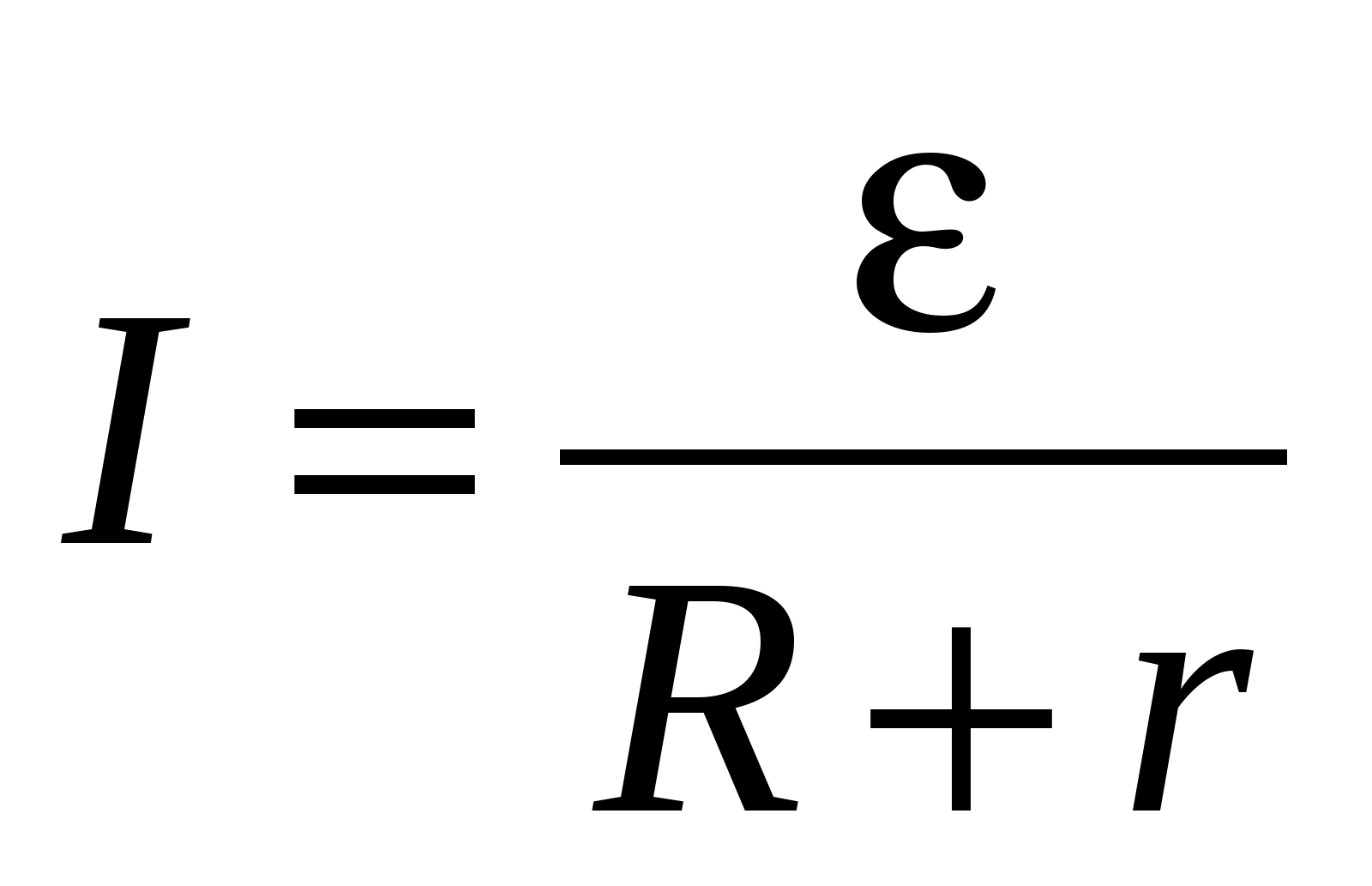 . (20)
. (20)
Ohm's law for a closed electrical circuit
In a closed electrical circuit source electromotive force current is equal to the sum of the voltage drops in all sections of the circuit.
5. Kirchhoff's first and second rules.
In practice, it is often necessary to calculate complex DC electrical circuits. A complex electrical circuit consists of several closed conductive circuits that have common sections. Each circuit can have multiple current sources. The current strength in individual areas can be different in magnitude and direction.
Kirchhoff's first rule is a condition for constant current in the circuit.
Let us call a branch node any point at which more than two conductors converge, then Kirchhoff's first rule : The algebraic sum of the current strength at the branching node is zero
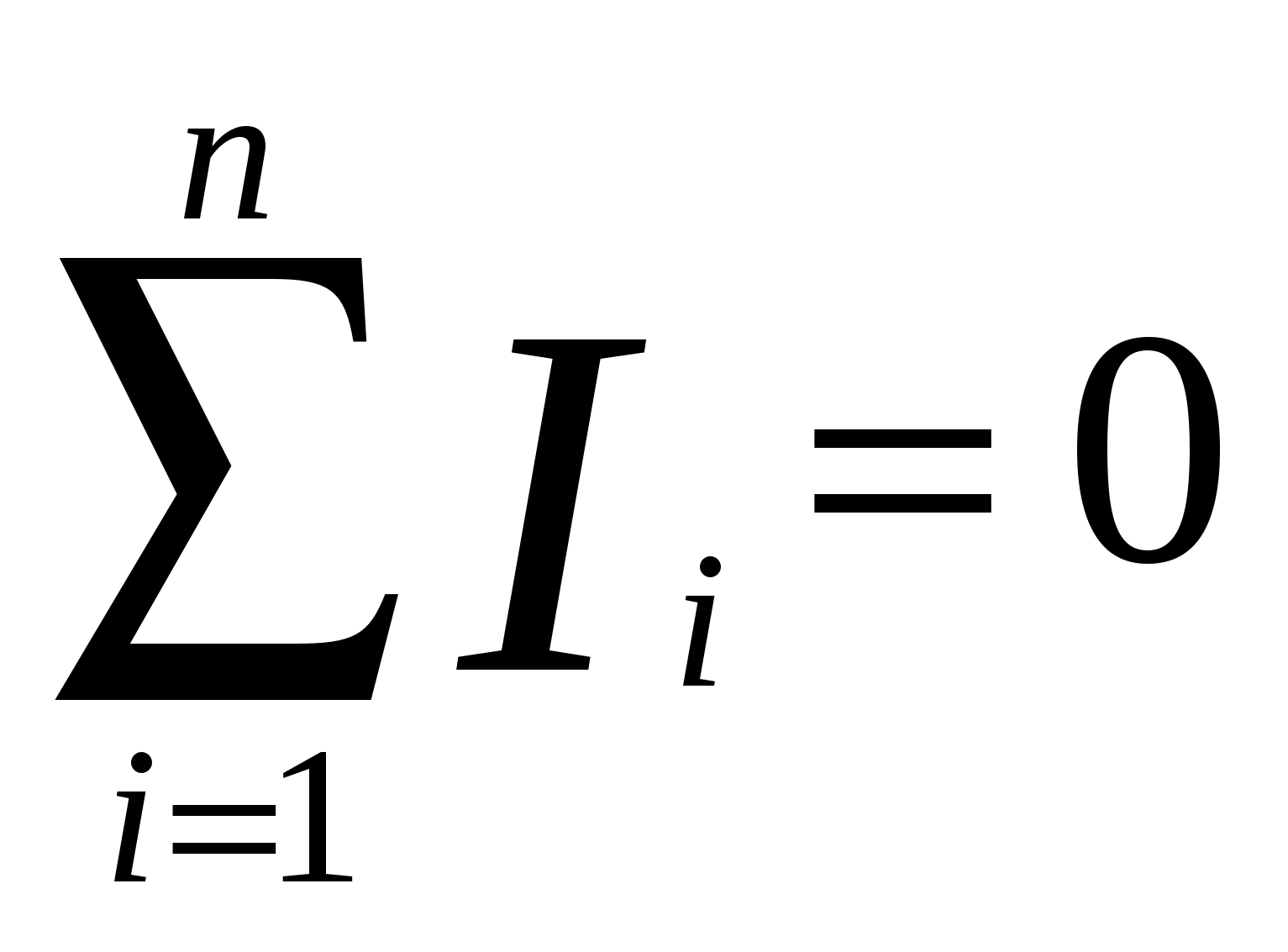 , (21)
, (21)
where n is the number of conductors;
I i – currents in conductors.
Currents approaching the node are considered positive, and currents leaving the node are considered negative.
For node A Kirchhoff's first rule will be written:
 . (22)
. (22)
Kirchhoff's second rule is a generalization of Ohm's law to branched electrical circuits. It sounds like this: In any closed loop of a branched electrical circuit, the algebraic sumI i for resistanceR i the corresponding sections of this circuit is equal to the sum of the emf applied in it i
To create an equation, you need to select the direction of traversal (clockwise or counterclockwise). All currents coinciding in direction with the circuit bypass are considered positive. The EMF of current sources is considered positive if they create a current directed towards bypassing the circuit. So, for example, Kirchhoff’s rule for I, II, III parts.
I – 1 + 2 = –I 1 r 1 – I 1 R 1 + I 2 r 2 + I 2 R 2 .
II – 2 + 3 = –I 2 r 2 – I 2 R 2 – I 3 r 3 – I 3 R 3 .
III – 1 + 3 = –I 1 r 1 – I 1 R 1 – I 3 r 3 – I 3 R 3 .
Based on these equations, the circuits are calculated.
6. Contact potential difference. Thermoelectric phenomena.
Electrons in a metal are in random thermal motion. Electrons with the greatest kinetic energy can fly out of the metal into the surrounding space. At the same time, they do work against the attractive forces from the excess positive charge resulting from the emission of electrons forming around the conductor “ electron cloud" There is a dynamic equilibrium between the electron gas in the metal and the “electron cloud”.
Electron work function - this is the work that needs to be done to remove an electron from the metal into airless space.
The lack of electrons in the conductor and the excess in the space surrounding it manifests itself in a very thin layer on both sides of the surface of the conductor (several interatomic distances in the metal). Therefore, the surface of the metal is an electrical double layer, similar to a very thin capacitor.
The potential difference between the capacitor plates depends on the work function of the electron.
 , (24)
, (24)
where e is the electron charge;
– contact potential difference between the metal and
environment;
A – work function (electron-volt – E-V).
The work function depends on the chemical nature of the metal and the condition of its surface (pollution, moisture).
The emergence of a contact potential difference between touching metal conductors was discovered at the end of the 18th century. Italian physicist Volt. He experimentally established Volta's two laws:
1. When connecting two conductors made of different metals, a contact potential difference arises between them, which depends only on the chemical composition and temperature.
2. The potential difference between the ends of a circuit consisting of series-connected metal conductors located at the same temperature does not depend on the chemical composition of the intermediate conductors. It is equal to the contact potential difference that arises when the outermost conductors are directly connected.
Thermoelectric phenomena.
Consider a closed circuit consisting of two metal conductors 1 And 2 . The emf applied to this circuit is equal to the algebraic sum of all potential jumps
If the temperatures of the layers are equal,
 , then =0.
, then =0.
If the temperatures of the layers are different, for example,  , Then
, Then
 , (26)
, (26)
where is a constant characterizing the properties of the contact of two metals.
In this case, in a closed circuit appears thermoelectromotive force , directly proportional to the temperature difference between both layers.
Thermoelectric phenomena in metals are widely used to measure temperature. For this purpose they are used thermocouples or thermocouples, which are two wires made of various metals and alloys. The ends of these wires are soldered. One junction is placed in a medium, temperature T 1 which needs to be measured, and the second - into an environment with a constant known temperature.
Thermocouples have a number of advantages over conventional thermometers: they allow you to measure temperatures in a wide range from tens to thousands of degrees of the absolute scale. Thermocouples have great sensitivity and therefore make it possible to measure very small temperature differences (up to 10 -6 degrees). For example: iron-constantan measures temperatures up to 500 °C and has a sensitivity of 5.3 10 -5 V/deg; platinum-platinum-rhodium (90% platinum and 10% rhodium) have a sensitivity of 6 10 -6 V/deg and are used to measure temperatures from the lowest to thousands of degrees.
A thermocouple can be used to monitor temperature changes over time. The ability to install a galvanometer at a considerable distance allows the use of thermocouples in automatic devices. To increase the sensitivity of thermocouples, their series connections, called thermopiles, are used.
7. Electric current in various environments.
Electric current in gases .
Gases under normal conditions are dielectrics , consist of electrically neutral atoms and molecules.
When gases are ionized, electric current carriers (positive charges) appear.
Electric current in gases is called gas discharge . To carry out a gas discharge, there must be an electric or magnetic field to the tube with ionized gas.
Gas ionization can occur under the influence of external influences - strong heating, ultraviolet and x-rays, radioactive radiation, when bombarding atoms (molecules) of gases with fast electrons or ions.
The measure of the ionization process is ionization intensity , measured by the number of pairs of oppositely charged particles arising in a unit volume of gas in a unit time period.
Impact ionization is called the separation of one or more electrons from an atom (molecule), caused by the collision of electrons or ions accelerated by an electric field in a discharge with atoms or molecules of a gas.
1. Non-self-sustaining gas discharge is the electrical conductivity of gases caused by external ionizers.
Current-voltage characteristics of gas discharge: as U increases, the number of charged particles reaching the electrode increases and the current increases to I=I To , at which all charged particles reach the electrodes. In this case, U=Uк
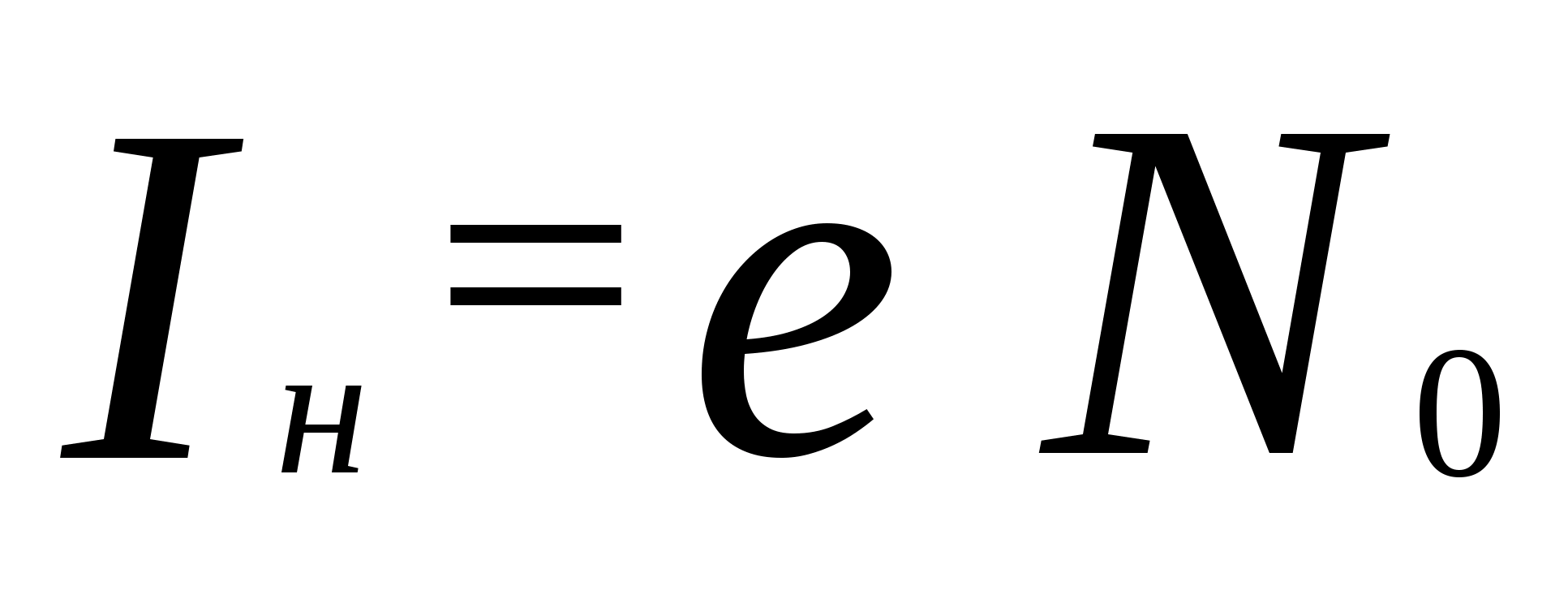 , (27)
, (27)
saturation current
where e is the elementary charge;
N 0 – maximum number of pairs of monovalent ions formed
in a volume of gas in 1 s.
Steep increase in current in the area AB associated with the occurrence of impact ionization.
2. Self-sustaining gas discharge – a discharge that continues after the termination of the external ionizer. Maintained and developed due to impact ionization.
A non-self-sustaining gas discharge becomes self-sustaining when U h– ignition voltage. The process of such a transition is called electrical breakdown of gas .
Depending on the gas pressure and voltage, there are:
1) glow discharge;
2) corona discharge;
3) spark discharge;
4) arc discharge.
Glow discharge used in gas light tubes, gas lasers.
Corona discharge – used for disinfection of agricultural crop seeds.
Spark discharge – lightning (currents up to several thousand Amperes, length – several kilometers).
Arc discharge (T=3000 °C – at atmospheric pressure, gas temperature is 5000…6000 °C). It is used as a light source in powerful spotlights and projection equipment.
Plasma – a special state of aggregation of a substance, characterized by a high degree of ionization of its particles.
Plasma is divided into
– weakly ionized( – fractions of a percent – upper layers of the atmosphere, ionosphere);
– partially ionized(some %);
– fully ionized(sun, hot stars, some interstellar clouds).
Artificially created plasma is used in gas-discharge lamps, plasma sources of electrical energy, and magnetodynamic generators.
Emission phenomena :
1. Photoelectron emission – ejection of electrons from the surface of metals in a vacuum under the influence of light.
2. Thermionic emission – the emission of electrons by solid or liquid bodies when they are heated.
3. Secondary electron emission – a counter flow of electrons from a surface bombarded by electrons in a vacuum.
Devices based on the phenomenon of thermionic emission are called electronic tubes .
Consider the diode and triode yourself.
Electric current in solids .
Metal is a crystal lattice. Positively charged site ions create an electric field inside the metal. The lattice nodes are located in a strict order, so the field they create is a periodic function of the coordinates. Therefore, electrons can only be in certain states corresponding to discrete values of their energy.
Since in solids an electron interacts not only with its own atom, but also with other atoms of the crystal lattice, the energy levels of atoms are split with the formation energy band .
In Fig. The splitting of the energy levels of isolated atoms as they approach each other and the formation of energy bands is shown.
The energy of these electrons may lie within the shaded areas called permitted energy zones . Discrete levels separated by areas illegal energy values – prohibited zones (their width is commensurate with the width of the prohibited zones).
The differences in electrical properties of different types of solids are explained by:
1) the width of the forbidden energy bands;
2) different filling of allowed energy bands with electrons
(conductor dielectric).
8. Current in liquids. Electrolysis. Faraday's laws.
Observations have shown that many liquids conduct electricity very poorly (distilled water, glycerin, kerosene, etc.). Aqueous solutions of salts, acids and alkalis conduct electricity well.
Electrolysis - the passage of current through a liquid, causing the release of substances that make up the electrolyte on the electrodes.
Electrolytes – substances with ionic conductivity. Ionic conductivity – ordered movement of ions under the influence of an electric field. Ions - atoms or molecules that have lost or gained one or more electrons. Positive ions – cations, negative – anions.
An electric field is created in the liquid by electrodes (“+” – anode, “–” – cathode). Positive ions (cations) move towards the cathode, negative ions move towards the anode.
The appearance of ions in electrolytes is explained electrical dissociation – decomposition of molecules of a soluble substance into positive and negative ions as a result of interaction with the solvent (Na + Cl - ; H + Cl - ; K + I - ...).
Degree of dissociation called the number of molecules n 0 , dissociated into ions, to the total number of molecules n 0
 . (28)
. (28)
During the thermal movement of ions, a reverse process of ion reunification occurs, called recombination .
M. Faraday's laws (1834).
The mass of the substance released at the electrode is directly proportional to the electric charge q passed through the electrolyte
 or
or  , (29)
, (29)
where k is the electrochemical equivalent of the substance; equal to the mass of the substance
released when passing through the electrolyte unit
amount of electricity.
 , (30)
, (30)
where I is the direct current passing through the electrolyte.
Electrochemical equivalents of substances are directly proportional to the ratio of their atomic (molar) masses to valency n
 , (31)
, (31)
where A is atomic mass;
n – valence.
Faraday's constant
where C is a universal constant for all elements.
F = 9.648 10 4 C/mol
the physical meaning follows from Faraday's unified law of electrolysis
Fields created by one charged... capacitor charge resistance current The resistances in the circuit are known and current. Determine... Solution - voltage in the circuit. . - current in the chain. - equivalent circuit resistance. - ...
Electric current in various environments (2)
Abstract >> Physics... Electric Current in Gases In gases there are non-independent and independent electric ranks. Leakage phenomenon electrical current... air, then electric current does not appear in a vacuum - there are no carriers electrical current. American scientist...
Electric current in liquid conductors
Practice report >> Physics1 The process of electrolysis in solutions and melts of electrolytes Electric current in metals none chemical processes no... there is a class of conductors in which electric current always accompanied by certain chemical changes...
